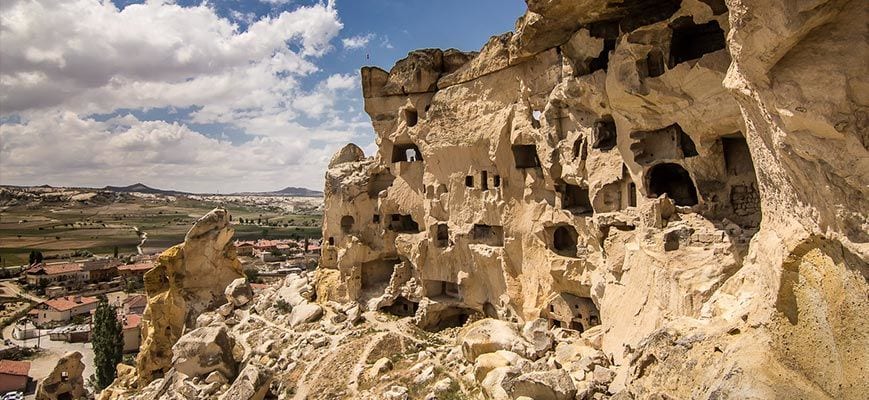No products in the cart.
Information
Cappadocia Information
The incredible region of Cappadocia (in Turkish: Kapadokya) is located in the center of Turkey and covers some 300 square kilometers of a unique landscape, almost surreal and unique in the world. In Capadocia volcanic activity formed a plain of ashes and by force of erosion and winds, strange steep rock formations were erected, while the harder layers of basalt and andesite remained in the upper part, in the form of covered cones.
These formations are known as “Chimeneas de Hadas”, because according to the first inhabitants of the area, they could not have been the work of humans and as fairies live underground, as these should be their chimneys.
The tuff ash was relatively easy to work with for the primitive tools of the time, so innumerable caverns and churches were sculpted in the cones and walls of the valley; as well as underground cities, which some believe date back to 4 thousand years ago, and which were expanding and extending after several generations.
According to some interpretations, the name “Cappadocia” is derived from the word Katpadukya or Land of beautiful horses, animals that were famous in the region to be offered as a gift to the kings of Assyria and Persia. The word “capadocios” to refer to the inhabitants of the region was used in a biblical passage.
Antiquity
There are numerous findings of prehistoric settlements in the region, especially in Köskhöyük (Niğde), Asiklihöyük (Aksaray) and Civelek, where several archaeological excavations still take place.
On the other hand, between the years 5 thousand and 4 thousand before Christ there were in the region independent and isolated principalities, which are believed to have established the first alliance in the history of Anatolia, against the Assyrians.
In contrast, the oldest written record of which there is evidence, the so-called “tables of Cappadocia”, belong to the second century BC. and describe the exchanges and exchanges of a period when Assyrian mercantile colonies settled in the area.
From Imperío Hıtıta to Satrapy Persian
At the end of the Bronze Age, Cappadocia was dominated by Hittite power, centered in Hattusa. In those years it became an important trading area on the Silk Road.
After the fall of the Hittite Empire, Cappadocia was ruled by a kind of feudal aristocracy that plunged the peasants and other inhabitants into a stag stage that would later favor their status as slaves in the face of foreign invasion, which reached the hands of the Persians.
Established by Darío, Cappadocia was included in the third Persian satrapy, although it remained governed by its own laws as long as they did not contradict the will of the Great King.
Alexander the Great and the DÃanastía de Arıarathes
After centuries of Persian domination, the empire came to an end and Alexander the Great tried to rule the area through Cabictas, one of his military commanders, but when Alexander died and the Macedonian empire dissolved, Cappadocia became independent again under the reign of Ariarathes , a Persian aristocrat, initiator of a dynasty whose descendants would end up allying themselves to the Roman Empire.
Roman and Bızantıno Empires
After several fights by regional powers, the Ariarathes dynasty ended up dissolving and the capadocios chose a new local regent with the imperial support, although during all this initial period the region changed of sides according to gambled the power in the throne of Rome. It was not until the year 17 that Cappadocia became an official part of the Roman Empire, then ruled by Trajan, who militarized the area and built new fortresses.
With the establishment of the new Byzantine Empire, Christianity began to be introduced into Cappadocia and the first churches were built, which in this particular case were dug into the rocks.
The Seljuks, the Crusaders and the Ottoman Empire
From the eleventh century began to be introduced into Cappadocia the so-called “Seljuks”, ancestors of the Turks of the West, which gradually conquered the region and expanded its urban areas, with new own constructions such as mosques and caravanserai, hostels that provided shelter to the caravans of the Silk Road and which were refined to offer new services to travelers. Throughout Anatolia there are numerous constructions of this type, which used to be 30 kilometers apart.
But when the Crusades broke out in these territories, the Crusaders expelled the Seljuks from the area and they had to retreat to the center, where they founded the bases of what would be the Ottoman Empire, which would eventually occupy the region until 1923, when After the defeat in the First World War, the Allied occupation and a war of independence, the new Republic of Turkey was established.
The Turkish Capadocía, a unique tourist destiny
Cappadocia is today a popular and popular tourist area, due to its peculiar, almost magical appearance, which makes it a favorite destination for travelers. The most important towns and sites in the region are Ürgüp, Göreme, the Ilhara valley, Selime, Uçhisar, Avanos and Zelve. Among the most interesting excavated cities are Derinkuyu, Kaymakli, Gaziemir and Ozkanak.
The ride in a hot air balloon over the lunar landscape, fairy chimneys and caverns, is possibly the most popular of the tourist services in Cappadocia, accessible in Göreme, as well as the visit to the many churches and chapels carved in the rock , with frescoes between the nine and eleventh centuries.

